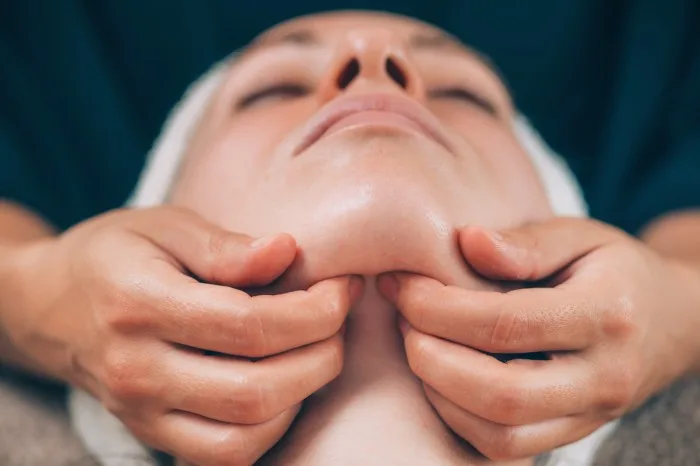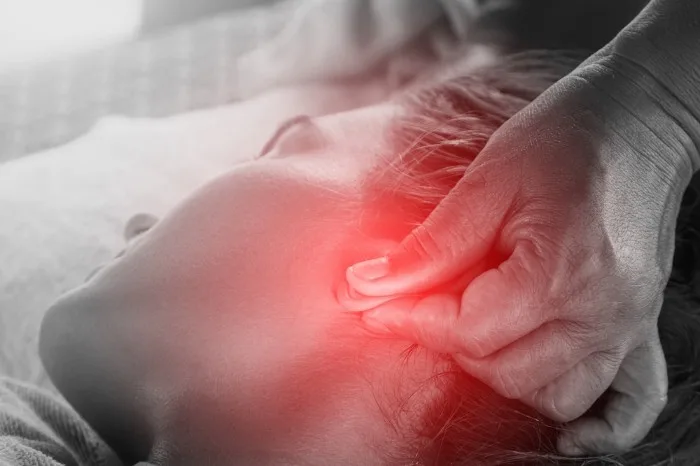If you are one of the millions who suffer from TMJ pain, you know how debilitating it can be. The good news is that some pressure points can relieve jaw pain. In this blog post, we will discuss four pressure points that can help to ease the pain and discomfort associated with TMJ disorder.
TMJ Disorder And Its Symptoms
TMJ (Temporomandibular joint) disorder can cause significant pain for some people and usually begins with clicking, popping, or grinding sounds.
The most common symptom is muscle pain. That pain can affect the muscles of the jaw joint, neck, face, and head. Other symptoms include:
- Difficulty chewing.
- Tiring of the jaw muscles quickly.
- Earaches.
- Dizziness caused by TMJ syndrome.
In many cases, TMJ dysfunction may be helped through TMJ acupressure approaches by working directly on the affected joint to reduce inflammation and release related muscle tension to reduce discomfort.
With TMJ therapy, your acupressure practitioner will carefully position their hands on or around the affected area, lightly applying pressure and then holding it until a release is felt before gradually moving to another spot and repeating until comfort has been restored.
These movements bring natural healing energy into the body while at the same time activating its own healing resources to help restore balance and alleviate any associated TMJ disorder symptoms.
Read More: Finding Relief from Depression with Acupressure
Jaw Massage

A jaw massage is a great way to relieve TMJ pain through TMJ acupressure. The jaw has many pressure points, which, when worked on, can help improve symptoms such as headaches, migraines, tingling in the face, and neck pain.
To begin this TMJ acupressure massage, use your index finger or middle finger, placing one firmly at the spot just in front of the ear lobe, close to where the jawbone meets beneath the ear.
Apply pressure and gentle massage in small circles for up to two minutes, then move to another pressure point towards the temple area. Continue with this method until all acupuncture points are massaged for about two minutes each – this will promote better blood flow with improved circulation and reduce TMJ pain.
Read More: 5 Ankle Pressure Points To Relieve Pain
Neck And Shoulder Release

One of the most effective TMJ acupressure techniques is neck and shoulder release. This technique involves applying firm pressure to both sides of the neck and atop the shoulders with your hands.
Doing so releases tension at these levels, which in turn helps to relieve TMJ-related pain. Massaging the area for an additional period after completing the pressure point exercise may also be helpful.
The neck and shoulder release TMJ acupressure technique reduces inflammation in these regions which are often very tender due to TMJ disorder and helps promote a general feeling of relaxation. Additionally, this type of TMJ pressure point can be done independently, meaning you can apply it when necessary from wherever you are.
Read More: Liver Acupressure Points: Everything To Know
Acupressure On The Earlobes

Acupressure is a therapeutic healing practice thousands of years old and practiced in many places worldwide. It applies pressure onto specific areas or trigger points in the body to help unblock energy pathways and promote relaxation. Many people find tremendous relief from TMJ pain when using TMJ acupressure.
One TMJ acupressure point can be found on the earlobes, known as Pressure Point #3. Although TMJ pain is often multifaceted and individualized, stimulating this pressure point can provide immediate relief from TMJ-related jaw clenching.
To do this, use your thumb to press gently onto each earlobe for 15-30 seconds each, take a deep breath, and concentrate on releasing any tension in your jaw muscles. If TMJ pain persists, it’s best to visit an experienced health practitioner or TMJ specialist to receive detailed care advice tailored to your specific needs.
Read More: Back Pressure Points Massage Guide
Temporal Mandibular Joint (TMJ)
Acupressure is a powerful and simple remedy to potentially heal TMJ pain. Pressure point #4, known as the temporal mandibular joint (TMJ) pressure point, is a high spot between your ear and jaw muscles.
Massaging this TMJ acupressure point can help to actively ease TMJ-related pains in your facial and neck muscles without requiring any medications. First, use two fingers on each side of your head and trace down the throat muscles until you locate the TMJ pressure points.
Gently press the TMJ points for about 3-5 minutes, pushing gradually deeper until you find a comfortable level and begin to feel pressure to relieve jaw tension. Then take some deep breaths and repeat this process if necessary. This TMJ self-massage can be an effective natural technique for quick relief from TMJ symptoms such as pain or tension in your jaw area.
Five Tips For Managing TMJ Pain
Managing TMJ pain and discomfort can be difficult, but there are five tips to find relief.
Here are the five tips for maintaining TMJ pain and discomfort:
- First, the basics: make sure you practice good posture when sitting or standing and maintain healthy habits like getting enough rest and drinking plenty of water.
- Next, try TMJ acupressure – this type of pressure work stimulates TMJ-specific acupressure points for TMJ to reduce inflammation and tension in the jaw muscles surrounding your TMJ.
- Additionally, DIY massages can help too! Use gentle pressure with your fingertips to massage TMJ-specific acupressure points for a few minutes each day.
- Performing simple exercises is also beneficial for TMJ pain management; you can use your index fingers to press down on each side of your jaw pain and hold for 15 seconds before releasing.
- And finally, consider utilizing holistic healing practices like Indian head massage or guided breathing/meditation techniques to calm your body and mind from TMJ symptoms.
With these five tips, you’ll be better equipped to manage TMJ pain and discomfort effectively so that it doesn’t consume or detract from your everyday quality of life.
Conclusion
Overall, TMJ pain can be extremely debilitating and uncomfortable, but it doesn’t have to rule your life. With the right acupressure techniques, you can reduce inflammation and tension in the jaw area, allowing for improved mobility and range of motion.
Remember to practice good posture when sitting or standing, use DIY massage techniques with your fingertips to stimulate TMJ-specific acupressure points, and perform simple exercises like pressing down on each side of your jaw with your index fingers.
Additionally, consider utilizing holistic healing practices like Indian head massage or guided breathing/meditation techniques to calm your body and mind from TMJ symptoms. With these tips, you’ll be better equipped to manage TMJ pain and discomfort effectively and get back to living without limitations.
Read More: Acupressure Points For Sciatica

